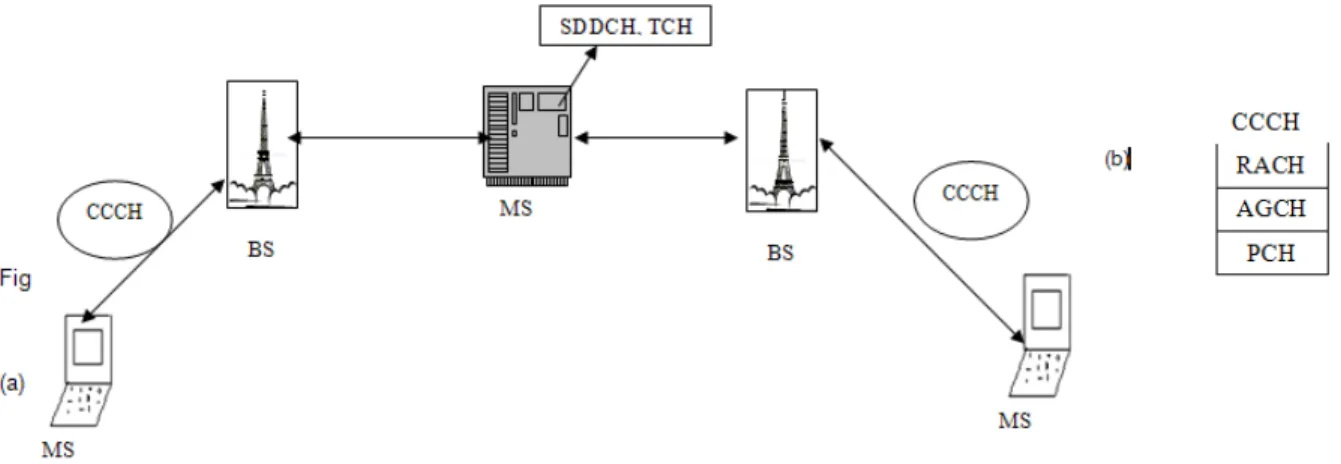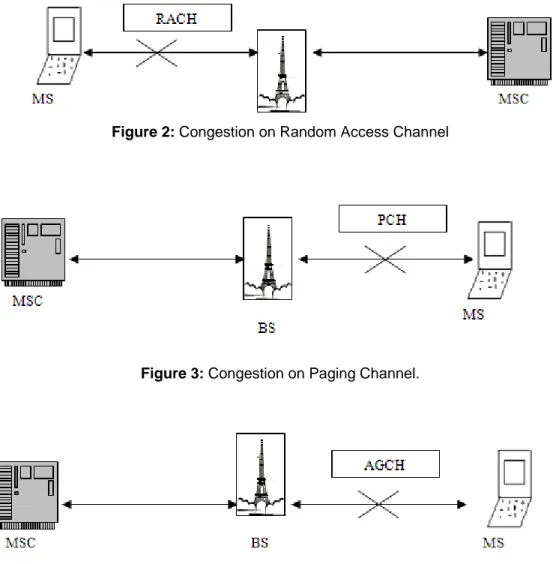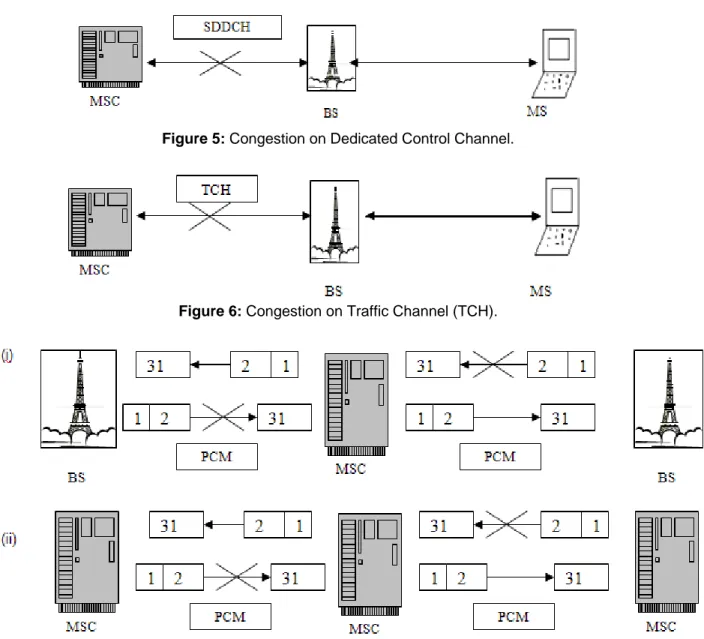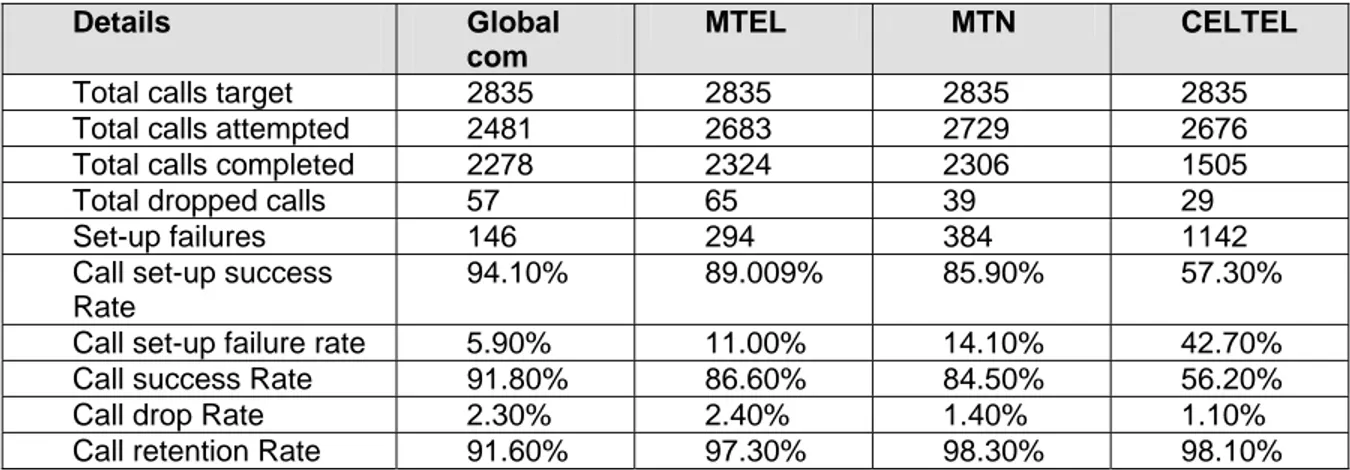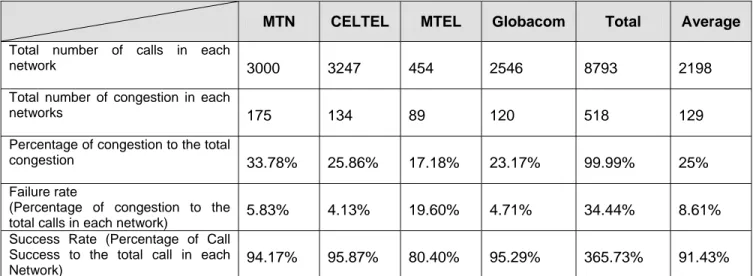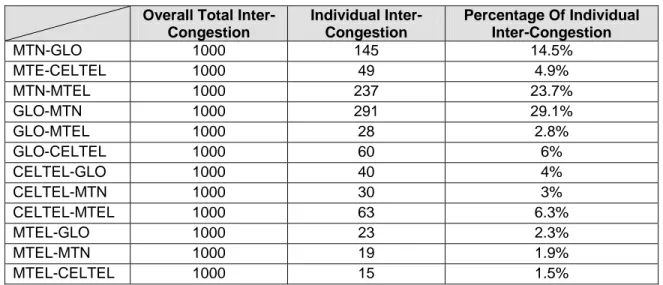Congestion Analysis on the Nigerian Global System for Mobile Communications
(GSM) Network.
B.M. Kuboye, M.Tech., ANCS1*, B.K. Alese, Ph.D., MIEE2, and O. Fajuyigbe, Ph.D. 2 1
Centre for Continuing Education, Federal University of Technology, PMB 704, Akure, Nigeria. 2
Department of Computer Science, Federal University of Technology, PMB 704, Akure, Nigeria. E-mail: kubonline@yahoo.co.uk*
ABSTRACT
In the past six years, Nigeria has embraced the Global System for Mobile Communication (GSM). As of today there are four different operators, namely, MTN, CELTEL (Formerly ECONET), Globacom, and Mtel. The limited facility vis-à-vis the large number of subscribers has resulted in high-level congestion. This paper identifies the areas on the GSM network where congestion occurred. The causes of congestion on GSM network and congestion comparative analysis on each of the GSM networks in Nigeria are also presented.
(Keywords: GSM, global system for mobile communications, telecom, network congestion)
INTRODUCTION
The most modern telephone technology is the cellular telephone, commonly referred to as the cell phone. A cellular telephone is designed to give the user maximum freedom of movement. As a result of this freedom, the number of mobile users keeps growing at an alarming rate. The role of cellular phones has risen with the improvement in services, reduction in service cost, and the ever-increasing range of services available through cell phones. Cellular systems began in the United States with the release of the advanced mobile phone service (AMPS) system in 1983. Asia, Latin America, and Oceanic countries adopted the AMPS standard, creating the largest potential market in the world for cellular (Mehrotra, 1997).
In the early 1980s, most mobile telephone systems were analog rather than digital. One challenge facing analog systems was the inability to handle the growing capacity needs in a cost-efficient manner because analog transceivers cannot handle more than one call at a point in
time. As a result, digital technology was welcomed. The advantages of digital systems over analog systems include ease of signaling, lower levels of interference, integration of transmission and switching, and increased ability to meet capacity demands (www.iec.org). Therefore, the limitations of analog system became clear as the number of subscribers increased. This gave way to the global system for mobile communications (GSM). GSM is more advanced than analog systems and uses digital data, which accommodates more subscribers. This technology increased the number of subscribers beyond expectations.
The GSM mobile telephone offers high quality voice communications and low bandwidth (9.6kb/sec) data connections for fax, short message service (SMS) and full dial-up connection to the Internet for e-mail and web browsing, usually requiring a mobile computer or intelligent handset. The need for mobile computing came as a result of the need to access information anywhere, anytime. The draw back of this system is its inefficient use of the radio resources.
The increasing need of mobile telephone and devices for data communication drives the need for a fast, reliable and available infrastructure. Mobile communications are now offering a lot of services ranging from mobile Internet, to multimedia, to e-mails. Mobile terminals are now becoming complex embedded systems, with stringent real time requirements for signaling and voice processing (Scourias, 1997). There are many technical challenges to be solved to make all of these components work as envisaged. The handsets sold over the next few years are likely to operate much more differently than those of today. GSM is going to play a practical and pragmatic role in making all of these features work. Many people are attracted to GSM because
of its mobility features. GSM is now a means of livelihood for many people as more individuals are engaged in phone-related businesses. Another thing that attracted many subscribers is the marketing strategies of the operators and competition to get many subscribers, even though their infrastructures cannot sustain them. Some operators complain that they pay an exorbitant fee to obtain licenses for operation in Nigeria, so they have to get as many subscribers as possible for them to recover their money. All of these factors have led to congestion on the Nigerian GSM network.
How can we maintain a good, secured, uninterruptible network for disaster responses, military control, public heath, safety, and law enforcement command in the face of this congestion? How can the congestion be minimized for everyone to enjoy the use of mobile communications? As we all know, the best way to acquire more subscribers and keep them satisfied is to make the service as easy to use and as reliable as possible. The need to satisfy the subscribers of wireless services and keeping them is paramount to the GSM companies. Thus the need to tackle the problem of congestion on the GSM network is paramount, as this will both be of advantage to operators and users.
In this research paper, the authors wish to develop a management framework for GSM congestion control, develop models for channel allocation for calls within the GSM network based on the Erlang –B call loading formula, and derive an algorithm for implementing the models to manage congestion of calls in the GSM network.
RESEARCH METHODOLOGY
A study of wireless communications including analog and digital system was carried out and special attention was given to GSM as a digital communication system. A careful study of congestion in GSM and other related networks was done. The points where congestion occurred on the GSM network were identified through observation of GSM stations such as MTN and GLO and through the administering of questionnaires.
Some models that are used around the world by some GSM companies to manage the problem were evaluated. The models were on block-time sharing, dynamic allocation with and without time slicing, first opportune call allocation, frequently recent allocation, and priority allocation. Thereafter, a comprehensive of a congestion management algorithm was derived to manage the congestion in GSM network in Nigeria.
LOCATION AND IDENTIFICATION OF CONGESTION AREAS ON GSM NETWORK
There are four areas of congestion in the GSM network. They are analyzed below:
Common Control Channels (CCCH): Common Control Channel is a group of control channels that support the establishment and maintenance of communication links between the mobile Stations and Base (Harte, et al 1999). It consists of Random Access Channel (RACH), Paging Channels (PCH), and Access Grant Channel (AGCH) (Figure 1).
RACH is used to make request for Network assignment, PCH is used to alert the mobile station of incoming calls, and AGCH is used to assign Mobile Station to a specific DCCH or SDCCH for onward communication. On these Common Control Channels, congestion occurs under three conditions:
Random Access Channel Congestion (RACHC) - occurs Is when there is no free Random Access Channel to use to either make a call or respond to a call (Figure 2). In this case, there is total blocking to either in-coming or outgoing calls.
Paging Channel Congestion (PCHC) - occurs when there is no free PCH to use in alerting the mobile station of an incoming message (Figure 3).
Grant Channel Congestion (AGCHC) - occurs when there is no free Access grant channel to authenticate the responding Mobile station (Figure 4).
When any of these three control channels is congested, there can’t be any call establishment between the sender and receiver. This failure is called a “Call Establishment Failure” (BoulMalf and Akhtar, 2003).
Figure 2: Congestion on Random Access Channel
Figure 3: Congestion on Paging Channel.
Dedicated Control Channel Congestion (DCHC): is the failure to allocate Stand-alone Dedicated Control Channel (SDCCH) to provide authentication to mobile station, location updating and assignments to TCHs during idle periods (Mehrotra, 1997) (Figure 5). The messages on SDCCH channel includes short message service. When making a call or responding to paging message for the allocation of an SDCCH for authentication, if there is no vacant SDCCH to use at that time, then the call will be terminated (Boulmaif and Akhtar, 2003).
Traffic channels congestion (TCHC): This failure occurs when an Access Grant Channel can not get any free traffic channel (TCH) to allocate to the request of the mobile terminal
through the random access channel. TCH is used to transfer voice, data, and control information and when there is no vacant TCH, the voice communication on the GSM network cannot be established (Figure 6).
Pulse Code Modulation Congestion (PCMC):
Pulse Code Modulation (PCM) is the link required to connect together the Base station (BS) and Mobile-switching center (MSC) (Figure 7). Each PCM can carry between 1 and 32 calls. When there is no free PCM to carry the call signals between the BS and MSC, then we have Pulse Code Modulation Congestion (PCMC). This type of congestion can either occur within the network or between networks (Hartel et al., 1999).
Figure 5: Congestion on Dedicated Control Channel.
Figure 6: Congestion on Traffic Channel (TCH).
THE LIKELY CAUSES OF CONGESTION IN GSM NETWORK IN NIGERIA
Lack of Adequate Base Stations: On December 29, 2003, Vanguard published a report where Adrian Wood, MTN MD, made a declaration that they have 1.5 million subscribers and that they had only 670 base stations all over the country. That gives an average of 2,238 subscribers to a base station, which is highly inadequate. By now the numbers of their subscribers has increased drastically due to a landslide reduction in the price of their network SIM card. It is doubtful if their base stations had a matching increase. The present ratio probably is about 10,000 subscribers to one base station.
Lack of Adequate Channels: Since there are not enough base stations, automatically, there will be a lack of adequate channels to support the subscribers and the service rolled out by these operators. The channels determine the total number of subscribers that can be allowed to use a base station simultaneously at any point in time (NCC, 2005). This trend remains the same because any time a base station is added to their network; a high-level of promotion will be rolled out in order to attract more customers.
Competition for Subscribers Among the Operators: It seems the highest priority of the GSM operators in Nigeria is the total sum of money they will make from the subscriber base and not the overall quality of service. So, they have catchy advertisements and often make false declarations to attract customers to their network, but they don’t have infrastructure to satisfy costumer demands. This action resulted in too many subscribers for their network to support.
Lack of End-to-End System: The GSM operators in Nigeria are still depending on radio waves to transfer speech and data from base stations to mobile switching centers. Radio wave signals are subject to interference from other electromagnetic waves generating systems such as radio and television. When such interference occurs, it could lead to call setup failure, call drop, or other distortions.
Lack of Good Quality Phones: In any radio link communication, it is the radio link between handset and base station that remains the weakest part of the communication system (www.elecdesign.com). If conditions are unfavorable, or the user moves into a tunnel
during a call, they will lose connection. Good quality handsets with higher frequency wave intensity will make a call more stable and reduce interference from another caller. This is justified by the regulation of the power control that transmits power between the terminal and base station. It is very important to have efficient power control in order to keep interference at a minimum.
Lack of Good Communication Terms Between Different Networks: One of the reasons for poor inter-network communication is the inability to agree on the sharing ratio of the revenue between the network operators. As a result the numbers of lines that are open for interconnectivity are small compared to the total number of lines. For example, as of December 2005, MTN had about 6 million subscribers and Mtel had about 3.5 million subscribers. Then MTN only agreed to open up 600 lines to the Lagos region and 300 lines to the Abuja region for interconnectivity with MTN. That is why subscribers find it difficult to interconnect in both networks.
Another situation that can also occur is congestion on the connecting networks like when a subscriber from a network A is calling from a network that is less congested to Network B, which is filled to capacity. In such a case, the call will not pass through the network.
Marketing Strategies and Pricing Schemes:
This also affects traffic behavior since this would have increased the number of subscribers on the network.
FACTORS THAT FAVOR INCREASES IN THE SUBSCRIBER BASE
The Ease of Communication Offered by GSM:
Many people in Nigeria embraced the GSM since it has solved the problem of fading or attenuation during calls. Also the phones are light and can be easily carried about. Noise or distortions caused by wired telephone are eliminated.
Elimination of Wired Connection: As long as the subscriber is within the cell area of his/her operator, communication will be established. This has really solved the problem of connection to cable done in PABX.
Voice Quality Service: The quality of voice service is far better than the analog wired service
since it is not as susceptible to distortion as that of wired telephones.
The Additional Data Service: The additional data services available on GSM, like SMS, make things easier for people and offer a wider array of communication options.
The Reduction in the Tariff: The service rate for country service remains the same and that of international service also remains the same, without increased tariff charges. This has really had an edge over the NITEL wired telephone service that depends on the distance for service rate.
The Low Acquisition Rate: The amount of money needed to acquire a GSM line and phone is significantly lower than the one users have to pay to have a wired NITEL telephone. This factor has really attracted many new GSM subscribers.
The Marketing Strategies: Before the arrival of Globalcom, subscribers were far fewer than today. Globalcom originated many novel marketing strategies. For example, when Globalcom started, it allowed people to pay as low as 25% of the total cost of acquisition in cash, and the rest of the money was deducted monthly as users loaded the corresponding recharge card(s). Also, they spawned the recent crash in the price of SIM card to N1. That is, if one buys a SIM card of N2000, you will have a free credit worth N1999. This is one of the prominent factors that really attracted subscribers (Amaefule, 2003).
COMPLAINTS BY THE SUBSCRIBERS
According to Jonnes (2005), complaints from subscriber in Nigeria include “If I try calling during the day, I often get the same message - ‘Network Busy’ or ‘Error in Network’ - even if the mobile phone at the other end is not being used”. Our survey revealed the following messages as being frequently announced or displayed to the users by the GSM operators in Nigeria.
Globalcom message:
• “Network busy”
• “The number you have dialed is not on the
Globalcom Network”
• “Error in connection”
• “No answer”
• “Number busy”
• “Not reachable at the moment; please try again later”
MTEL message:
• “Number not responding”
• “Network temporary busy” MTN message:
• “Error in connection”
• “Network busy”
• “The number you are calling is unavailable
CELTEL
• “Error in connection”
• “Network busy”
These messages show the lack of support of our operators to the subscribers. Those messages have been programmed into their equipment and it is speculated that they are picked probably randomly and announced to the users. Sometimes in response to a return call to a number that has just called you, one receives a message “Sorry number not on the subscriber network”. This often raises the questions about the veracity of these statements.
ANALYSIS OF QUALITY OF SERVICE OF THE OPERATORS BY NIGERIA COMMUNICATION COMMISSION (NCC)
A report of NCC on network Quality of Service and performance of the GSM networks in Nigeria was published in The Guardian newspaper on March 22, 2005. The NCC conducted the research with the help of some consultants - ARIT solutions and ATIO Corporation - to help confirm the complaints of subscribers. The test was conducted between 21st September and 11th October 2004 (NCC, 2005).
The following test samples were used for voice network performance or quality for the duration of the tests.
Calls per network per day – 135 Calls per network per week – 945
Total test calls per network for project – 2835 The key performance indicators measured were: Call setup success rate
Call Setup Failure Rate Call Success Rate Call Drop Rate
Call Retention Rate System Response Time Handover Statistics
Number of Handovers per Call Voice Quality as A MOS Value
Voice Quality is computed using the mean opinion scores (MOS), which estimate the overall acceptability of quality of voice communication using a 5- point rating scale, with 5 as excellent and 1 as bad. The test was conducted in three cities in Nigeria; Lagos, Abuja, and Port Harcourt. Note that 100% success rate was not achieved due to low network availability. Percentage success rate is base on calls completed against total calls attempted. From the summary results in Table 1, it can be seen from the subscriber perspective at the time of this test that the performance ratio of the operators ranges from 56.20% to 91.80%
ANALYSIS OF THE QUESTIONNAIRE ADMINISTERED AND CONCLUSIONS
In this questionnaire, respondents were queried on how many times they experienced congestion and call-drop (or call-break) for the last thirty days so as to establish a current congestion and call-drop state. For every questionnaire, the respondents had to fill in their network number
even if they didn’t fill in their names so as to let us know their network. The questionnaire was administered in Lagos between July 25 and August 9, 2005. These people had handsets with different networks. They were from different locations within Lagos. Our expectations were that there would be minimal congestion problems because Lagos has the largest population, and all the four operators concentrate their efforts mostly on Lagos and Abuja. The results, however, showed that Lagos also experienced heavy congestion problems. Three out of the four operators have their headquarters in Lagos. From a customer service perspective, it is unacceptable that such a level of congestion is still being experienced in Lagos. This data does not bode well for more rural or isolated locations in Nigeria. The questions in the questionnaire address the following areas:
Congestion within network, which is called Intra- congestion.
Congestion between different networks, which is called Inter- congestion.
The incomplete calls called drop (or call-break) within networks. Call-drop means the two parties in conversation were unable to finish their conversation. This means that the call just ended abruptly.
The incomplete calls called drop (or call-break) between networks.
Table 1: Total Call Statistics Summary.
Details Global
com
MTEL MTN CELTEL
Total calls target 2835 2835 2835 2835
Total calls attempted 2481 2683 2729 2676
Total calls completed 2278 2324 2306 1505
Total dropped calls 57 65 39 29
Set-up failures 146 294 384 1142
Call set-up success Rate
94.10% 89.009% 85.90% 57.30%
Call set-up failure rate 5.90% 11.00% 14.10% 42.70%
Call success Rate 91.80% 86.60% 84.50% 56.20%
Call drop Rate 2.30% 2.40% 1.40% 1.10%
From Table 2, subscribers experienced the most congestion in the MTEL network when compared to the total calls followed by MTN. Call drop statistics in Table 3, follow likewise. From the authors’ observations, MTN has the highest number of subscribers due to their quarterly promotions and catchy advertisements, but they do not have equivalent equipment or infrastructure to sustain these subscribers on their Network.
Mtel did not have many subscribers but they still lack sufficient resourcess to sustain their small network. Most people find it difficult to drop MTN because long established relationships based on MTN line service. A coping mechanism that many people employ is to have two or three handsets with different providers, so that if one fails they move on to another.
MTN’s rates are the highest of the service providers. Any other GSM operators who could not reach agreement with them, were barred from using their network.
CELTEL and GLO tend to be fair when considering both the congestion and call drop issues. GLO performance was due to their GPRS 2.5G equipment they have installed in some of
their base stations. This equipment creates more room for calls and provides end-to-end data throughput. Only GLO provides services which allow users to browse their e-mail addresses. Some banks are in partnership with Globacom so that their customers can check their account balances as a result of their GPRS System. CELTEL had seriously intensified their efforts to satisfy people especially in the southwest of Nigeria.
MTN and GLO maintain the lead in minimizing inter-congestion as well as call drops ( Table 4 and Table 5). The MTN system has more subscribers but insufficient equipment to support them. Also because of the problems in revenue sharing, MTN manages to restrict its lines to other operators, obstructing the free flow inter-connection. MTN and GLO also have a business rivalry and as a result, they are not easily open to one another.
GLO and Vmobile are better when comparing them with other operators. The congestion problems are very minimal and people’s calls are fairly maintained. From the interviews conducted with some commercial phone operators, GLO always has the poorest services in the evening.
Table 2: Congestion Statistics within Network.
MTN CELTEL MTEL Globacom Total Average
Total number of calls in each
network 3000 3247 454 2546 8793 2198
Total number of congestion in each
networks 175 134 89 120 518 129
Percentage of congestion to the total
congestion 33.78% 25.86% 17.18% 23.17% 99.99% 25%
Failure rate
(Percentage of congestion to the
total calls in each network) 5.83% 4.13% 19.60% 4.71% 34.44% 8.61% Success Rate (Percentage of Call
Success to the total call in each
Table 3: Call Drop Statistics within Network.
MTN CELTEL Mtel GLO Total Average
Total number of calls in each
network 3000 3247 454 2546 8793 2198
Total number of call drop in each
network 45 31 10 19 105 26.25
Percentage of call drop to the total
drop in each network 42.86% 29.52% 9.52% 18.10% 100% 25%
Failure rate (Percentage of call drop
to the total number of calls) 1.50% 0.95% 2.20% 0.75% 5.4% 1.35% Success Rate
98.50% 99.05% 97.80% 99.25% 394.6% 98.65%
Table 4: Congestion Statistics Between Networks.
Overall Total Inter-Congestion Individual Inter-Congestion Percentage Of Individual Inter-Congestion MTN-GLO 1000 145 14.5% MTE-CELTEL 1000 49 4.9% MTN-MTEL 1000 237 23.7% GLO-MTN 1000 291 29.1% GLO-MTEL 1000 28 2.8% GLO-CELTEL 1000 60 6% CELTEL-GLO 1000 40 4% CELTEL-MTN 1000 30 3% CELTEL-MTEL 1000 63 6.3% MTEL-GLO 1000 23 2.3% MTEL-MTN 1000 19 1.9% MTEL-CELTEL 1000 15 1.5%
Table 5: Call Drop Statistics Between Networks.
Overall Total Call Drop
Individual Inter Call Drop Percentage Of Individual Call Drop MTN-GLO 745 97 13.02% MTN-CELTEL 745 105 14.09% MTN-MTEL 745 190 25.50% GLO-MTN 745 38 5.10% GLO-CELTEL 745 25 3.36% GLO-MTEL 745 17 2.28% CELTEL-GLO 745 64 8.59% CELTEL-MTN 745 73 9.80% CELTEL-MTEL 745 86 11.54% MTEL-GLO 745 18 2.42% MTEL-MTN 745 17 2.28% MTEL- CELTEL 745 15 2.01%
REFERENCES
1. Amaefule, C.S. 2003. “The GSM Communication Explosion in Nigeria”. Proceedings of the NCS Conference 2003. 14:163 – 182.
2. Boulmalf, M. and Akhtar, S. 2003. “Performance Evaluation of Operational GSM Air-Interface (UM)”. http://www.iec.com
3. Hartel, L.R. and Livingstone, G. 1999. GSM
Superphones. McGraw-Hill: New York, NY.
4. International Engineering Consortium. 2008. “Cellular Communicators”. http://www.iec.org 5. Jonnes, G.K. 2005. “T Mobile, Faster, Easier,
More Secure”. http://www.t-mobile.com 6. Mehrotra. A. 1994. Cellular Radio Analog and
Digital Systems. Artech House, APDG Publishing: Norwood, MA.
7. Mehrotra, A. 1997. GSM System Engineering. Artech Home, Inc.: Norwood, MA.
8. Nigeria Communication Commission (NCC). 2005. “A Report on Network Quality of Service and Performance of the GSM Networks in Nigeria”.
The Guardian Newspaper. Tuesday, March 22,
2005.
9. Scourias, J. 1997. “Overview of the Global System for Mobile Communication”.
http://www.iec.org/online/tutorial
10. Electronic Design. 2008. “Data over Cellular’’. Brand Communication. www.elecdesign.com.
ABOUT THE AUTHORS
Mr. B.M. Kuboye attended the Federal University of Technology, Akure, Nigeria where he obtained his Bachelor and Master of Technlology degrees in Computer science. He is currently pursuing his Ph.D. degree from the same University. He is member of the Nigeria Computer Society.
Dr. B.K. Alese, MNCS, MACM, MIEEE is a Lecturer I in the Department of Computer Science, Federal University of Technology, Akure, Nigeria. He holds a Bachelor of Technology (B.Tech.) degree in Industrial Mathematics from The Federal University of Technology, Akure (1997). He also holds a
Master of Technology (M. Tech.) and Doctor of Philosophy (Ph.D.) degree in Computer Science from the same University (2000 and 2004, respectively). Dr. Alese Joined the services of the Federal University of Technology, Akure in 1998 as a Graduate Assistant. He was once the Assistant Director of the Post Graduate Diploma Program of the University. He is a member of the University Senate and various committees in the University. His research interests are in information security, quantum communication, computer networks, and digital signal processing. He has more than 40 publications in both local and international journals and conference proceedings. He has attended many conferences and workshops and is a member various professional organizations such as the Nigerian Computer Society (NCS), Association for Computing Machinery (ACM), and Institute of Electrical and Electronics Engineers (IEEE), New York.
Dr. O. Fajuyigbe, holds a B.Sc. Mathematics (London) 1964, Dipolma Mathematiker (Bonn) 1968, Ph.D. Mathematics (Southampton) 1972, and M.Sc Computer Science (Oregon State University) 1978. He is Currently an Associate Professor in the department of Computer Science and Information Technology, Bowen University, Ogbomoso, Nigeria.
SUGGESTED CITATION
Kuboye, B.M., B.K. Alese, and O. Fajuyigbe. 2009. “Congestion Analysis on the Nigerian Global System for Mobile Communications (GSM) Network”. Pacific Journal of Science and Technology. 10(1):262-271.
